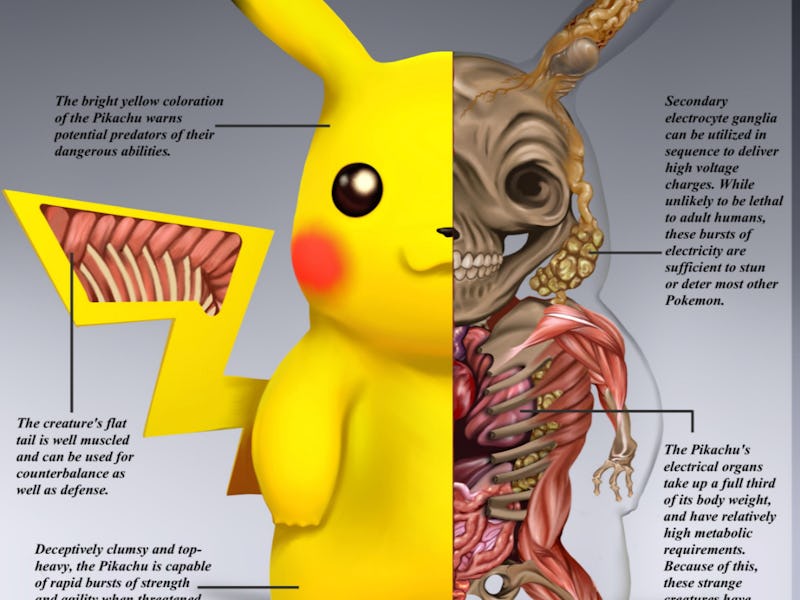Pokéanatomy Is a Thing, and It's Bizarrely Fascinating
Artist Christopher Stoll creates fantastical images informed by science.

Since 1996, Pokémon have been a part of our lives – pocket monsters that we could catch, train, and be best friends with. Today with Pokémon Go the world of these ever evolving creatures feels more real than ever. But is it possible to make Pokémon even more realistic?
Enter Christopher Stoll, an artist whose conceptual designs often focus on mixing the fantastical with the mundane. In his Pokéanatomy series, Stoll imagines the anatomy of various Pokémon. Stoll will be launching a Kickstarter for a book of his project in late October complete with the full set of his Pokémon anatomy art pieces. He shared with Inverse some of his art and why he was inspired to literally get inside the head of Pikachu.
What inspired you to do this project? Have you been interested for a while in the mix between the scientific and the fantastical?
I’ve always had a love of biology and the natural world, and much of Pokénatomy’s inspiration came from my previous work, the anatomical art-book bestiary A Natural History of the Fantastic. It’s sort of Gray’s Anatomy meets Lord of the Rings, and lays out the biology and behavior of classic fantasy creatures like dragons, harpies, unicorns, and centaurs.
It’s through this book that I established my love for integrating fantasy and the biological sciences. The Pokémon aspect of the project was almost accidental. I was 8-years-old when the original Pokémon Game Boy games came out in the United States, but only recently rediscovered my love for the franchise when Pokémon Go came out. One day after a long walk outside trying to track down a Scyther I came home, plopped down, and started absentmindedly drawing diagrams of Pokémon anatomy. After a few sketches I knew that I’d found a subject worth exploring, and I decided to return to the world that had captivated me as a kid.
How long have you been working on the Pokénatomy project?
I’ve been illustrating these particular images for just under two months. So far I have released 13 images and completed about 30 total Pokénatomy pieces. I hope to make a Pokénatomy entry for every one of Nintendo’s original 151 Pokémon. Right now I’m releasing a new one each week, but that pace might pick up in the near future.
How do you go about imagining what each Pokémon’s anatomy would look like? Did you use other anatomical examples, like animal models, for guidance?
A lot of the original Pokémon are based on real-world organisms, so I always start a Pokénatomy piece by researching their inspiration. For the sake of the project, I’ve found myself thumbing through books on botany, herpetology, exotic fish, and even embryology. Once I feel that I have a grasp of the basic biology, I begin to tease out the more fantastical elements.
Researching real animals is helpful, but the Pokémon world is full of ghost creatures, walking plants, psychic phenomenon, and sentient code. Eventually, you have to fill in the scientific gaps yourself.
I imagine that a lot of imagination has to go into this. When describing the Pokémon, how much of this was your imagination versus research that went into the Pokémon world?
The goal is ultimately to describe these creatures as realistically as possible, but a lot of it ends up coming right out of my imagination. Some Pokémon possess bodies and abilities that totally defy the laws of physics, and there’s always a temptation to just invent an organ and label it the “fire sack” or “psychic gland” and leave it at that. I try to resist that urge wherever possible, and in those cases where hard-science is unavailable I try to present interesting and alternative perspectives on these characters based on the theoretical rather than the outright fantastic.
Ultimately, it’s probably about 50/50. Some Pokémon trend more into outright fantasy, while others are rooted more soundly in research about the real world.
Do you have a favorite drawing in this series?
My favorite one is Abra, but that particular image hasnt been released yet. As for the ones already out there, I especially love Voltorb and Bulbasaur. In my mind, both of them strike a good balance between the imaginary and the plausible, enhancing the Pokémon world while still emphasizing why people enjoy these creatures in the first place.
What Pokéanatomy do you think was the most challenging to do?
Again, it’s not quite out, but Exeggcute was a huge headache for me. I envisioned this communal organism, like a Portuguese man-of-war, where each individual egg performed a specific function. It took a lot of research and I ended up drawing and redrawing them over and over trying to get my thoughts on the page.
As for the ones already out, Staryu was a real challenge. The biology of Starfish is already so alien I actually felt like I had to tone down the actual anatomy so that the readers wouldn’t think I’d made it all up.
This interview has been edited for brevity and clarity.